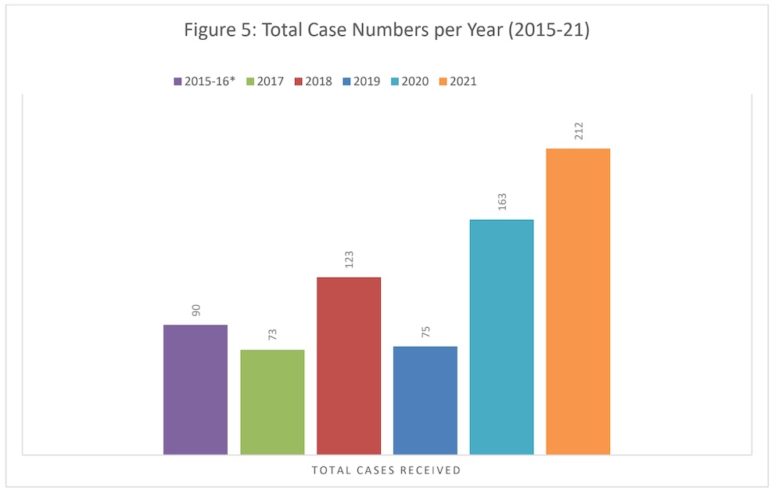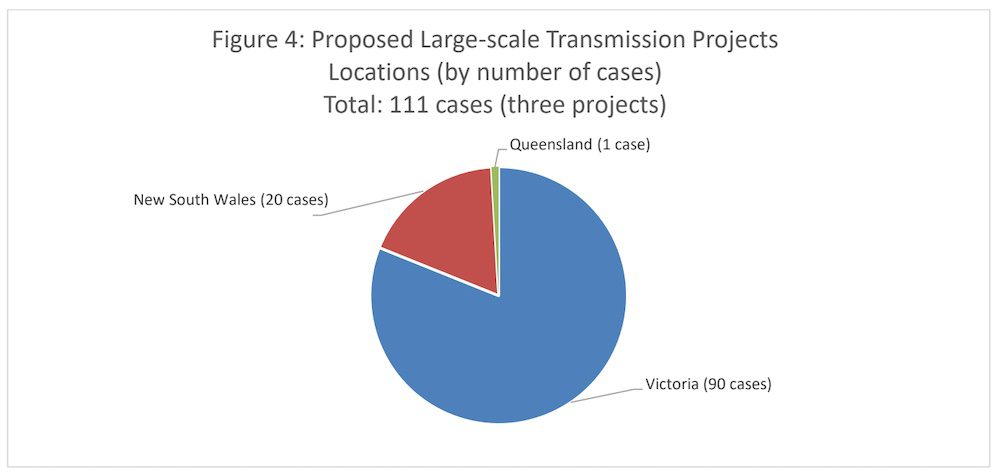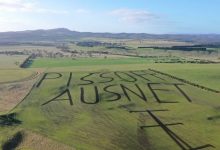Plans for major electricity transmission projects considered vital to Australia’s transition to renewables attracted more than 100 complaints from affected residents and landholders in a period of just nine months, a new report has found.
The annual report to the federal government from the office of the Australian Energy Infrastructure Commissioner – originally established to manage complaints against wind farms, but later taking in big solar and transmission projects – was tabled in federal parliament on Thursday.
Commissioner Andrew Dyer says his office received a “significant increase” in the overall number of cases over the course of 2021 – 212 compared to 163 in 2020 – and a record number since the office was established in late 2015.

Of that number, 111 of new cases related to just three of a series of major proposed transmission projects – a particularly significant proportion, Dyer notes, considering the expansion of the office’s role into transmission projects didn’t happen until March.
“Since the announcement or our role expansion in March 2021, our Office received 111 new cases in the remainder of 2021 related to major proposed transmission projects,” the report says.
“In terms of overall case numbers, 2021 has been the busiest year in the history of the Office. In addition to the large number of new cases received about transmission projects, there remained a steady flow of new cases about wind and solar farm projects.”

The numbers highlight the “range of challenges” developers of major transmission projects are already coming up against in dealing with affected landholders, neighbours and the broader community.
As Dyer notes, the biggest challenge will be with “green-field” transmission projects requiring a new route path and acquisition of new easements along that route – huge towers and wires where there perhaps used to be a view.
These projects include the HumeLink project in New South Wales, Project EnergyConnect linking South Australia and NSW, Marinus Link (TAS/VIC), VNI West (NSW/VIC) and the Western Victoria Transmission Network Project – ‘WestVicTNP’ (VIC).
All of these projects, not to mention the new network infrastructure being built to accommodate Snowy 2.0 in New South Wales, have met with varying levels of opposition from local communities as well as from environmental groups.
According to the report, however, just three of these projects were the focus of all 111 of the complaints and, as the chart below shows, the vast bulk of that number (90) was focused on one of the Victorian projects, with 20 relating to a NSW project, and then just one case in Queensland.

The report does not name the individual projects behind the case numbers. But as RenewEconomy has reported, AusNet Services’ Western Victoria project – now called the Western Renewables Link – has had a particularly rocky path.
That project’s troubles reached a nadir right in the middle of 2021 when members of a community consultation group accused the network operator of “misrepresentation, deception and lack of empathy” in its dealings with them.
In NSW, meanwhile, Transgrid has its work cut out with the $2.3 billion Project EnergyConnect linking NSW and Victoria, and will play the central role in the proposed HumeLink, Sydney Ring, and New England renewable energy zone projects, and a major role in VNI West link between NSW and Victoria.
But responsibility for ushering through these vital projects doesn’t lie solely with transmission companies – as David Leitch explains very well here, and this major report details here, it’s also beholden on governments and regulators to get these projects over the line without putting huge chunks of the community offside or out of pocket.
Back in March, before his party was elected to federal government in May, then shadow energy minister Chris Bowen showed signs that he understood this, in an address to the Energy Networks Australia conference.
At the time, Bowen said the process that regulates major network investments was not ‘fit for purpose’, and was failing to serve community interests – and he said a Labor government would address the problem.
“A near-total rebuild of the grid comes with challenges, particularly for the communities where projects will be built,” Bowen told the conference.
“We are seeing that right now in relation to the Western Victoria Transmission Network Project, as well as the HumeLink project. It would be easy, but wrong, to dismiss those concerns as just NIMBYism.”
“In my experience, most concerned community members are not anti-renewables, anti-transmission or anti-progress. Nor, in most cases, are they opposed to the projects going ahead if their concerns are addressed.”
But that list of potential concerns for local communities and landholders is long, according to the report, ranging from perceived potential for increased bushfire risk, the potential for new grid and substations to attract more solar and wind farms, loss of property value, and reduction of productive agricultural land.
Helpfully, Dyer’s comprehensive 94-page report offers a lot of recommendations for a smoother way forward, many of them gleaned from years of working through conflicts over the placement of wind farms and – more recently – solar farms.
On community engagement and social license, the report says landholder cooperation is “vital,” and sufficient time and money must be dedicated to developing effective working relationships with them in the initial stages of project investigation.
Interestingly, the report also questions the current ‘multi-corridor approach’ to route selection and community consultation being used to select a final transmission line route, saying it may be having “unintended consequences, resulting in widespread project opposition from numerous landholders and communities.”
An alternative approach, it says, “may be to internally determine the preferred route corridor and then fully engage the community and landholders, taking on board feedback and insights to fine tune the actual final route.”
The report also finds current compensation arrangements for landholders hosting transmission and related infrastructure “may be perceived be inequitable when compared with landholder arrangements for hosting wind farms and solar farms.”
This report says this inequity – which has been pointed out a number of times by various experts on the subject of social license for transmission projects – “could affect the success rate of negotiated agreements for hosting transmission lines and harm the ability to engender good will.”
Another key, says Dyer, is to have “clear and consistent protocols” for working with landholders, such as for land access, that must be followed by proponents, including “consistent guidelines that clarify what activities a landholder can and cannot do near or within a transmission line easement.”
In a statement on Thursday, minister Bowen said the AEIC report was “important” for an industry undergoing rapid change.
“Social license for energy infrastructure is critical to ensuring the transformation of Australia’s grid is as smooth as possible and not enough attention has been paid to getting this right,” Bowen said.
“That’s why I am pleased to table the Australian Energy Infrastructure Commissioner’s report today. I am also pleased to have committed to reforming the RIT-T process to ensure it is fit for purpose for the pipeline of energy infrastructure projects ahead.”










